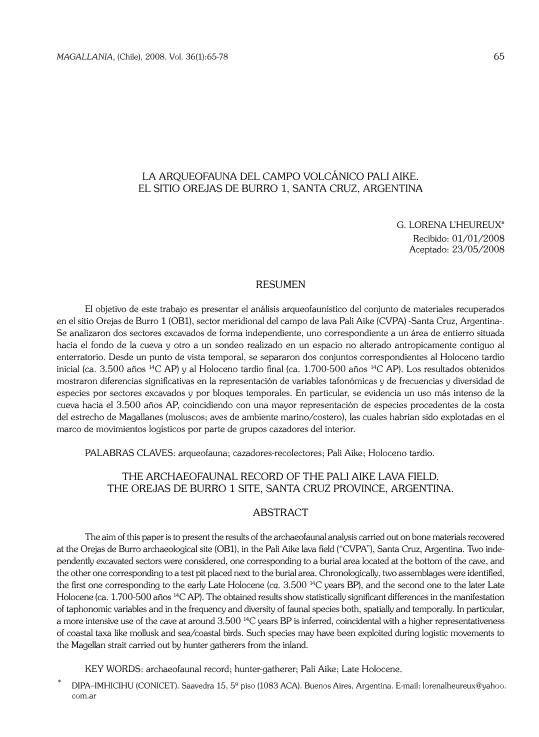Artículo
El objetivo de este trabajo es presentar el análisis arqueofaunístico del conjunto de materiales recuperados en el sitio Orejas de Burro 1 (OB1), sector meridional del campo de lava Pali Aike (CVPA) -Santa Cruz, Argentina-. Se analizaron dos sectores excavados de forma independiente, uno correspondiente a un área de entierro situada hacia el fondo de la cueva y otro a un sondeo realizado en un espacio no alterado antropicamente contiguo al enterratorio. Desde un punto de vista temporal, se separaron dos conjuntos correspondientes al Holoceno tardío inicial (ca. 3.500 años 14C AP) y al Holoceno tardío final (ca. 1.700-500 años 14C AP). Los resultados obtenidos mostraron diferencias significativas en la representación de variables tafonómicas y de frecuencias y diversidad de especies por sectores excavados y por bloques temporales. En particular, se evidencia un uso más intenso de la cueva hacia el 3.500 años AP, coincidiendo con una mayor representación de especies procedentes de la costa del estrecho de Magallanes (moluscos; aves de ambiente marino/costero), las cuales habrían sido explotadas en el marco de movimientos logísticos por parte de grupos cazadores del interior. The aim of this paper is to present the results of the archaeofaunal analysis carried out on bone materials recovered at the Orejas de Burro archaeological site (OB1), in the Pali Aike lava field (“CVPA”), Santa Cruz, Argentina. Two independently excavated sectors were considered, one corresponding to a burial area located at the bottom of the cave, and the other one corresponding to a test pit placed next to the burial area. Chronologically, two assemblages were identified, the first one corresponding to the early Late Holocene (ca. 3.500 14C years BP), and the second one to the later Late Holocene (ca. 1.700-500 años 14C AP). The obtained results show statistically significant differences in the manifestation of taphonomic variables and in the frequency and diversity of faunal species both, spatially and temporally. In particular, a more intensive use of the cave at around 3.500 14C years BP is inferred, coincidental with a higher representativeness of coastal taxa like mollusk and sea/coastal birds. Such species may have been exploited during logistic movements to the Magellan strait carried out by hunter gatherers from the inland.
La arqueofauna del Campo Volcánico Pali Aike. El sitio Orejas de Burro 1, Santa Cruz, Argentina
Título:
The archaeofaunal record of the pali aike lava field. the orejas de burro 1 site, santa cruz province, Argentina
Fecha de publicación:
12/2008
Editorial:
Universidad de Magallanes. Instituto de la Patagonia. Centro de Estudios del Hombre Austral
Revista:
Magallania
ISSN:
0718-2244
Idioma:
Español
Tipo de recurso:
Artículo publicado
Clasificación temática:
Resumen
Palabras clave:
ARQUEOFAUNA
,
CAZADORES-RECOLECTORES
,
PALI AIKE
,
HOLOCENO TARDÍO
Archivos asociados
Licencia
Identificadores
Colecciones
Articulos(IMHICIHU)
Articulos de INST.MULTIDISCIP.DE HISTORIA Y CS.HUMANAS
Articulos de INST.MULTIDISCIP.DE HISTORIA Y CS.HUMANAS
Citación
L'heureux, Gabriela Lorena; La arqueofauna del Campo Volcánico Pali Aike. El sitio Orejas de Burro 1, Santa Cruz, Argentina; Universidad de Magallanes. Instituto de la Patagonia. Centro de Estudios del Hombre Austral; Magallania; 36; 1; 12-2008; 65-78
Compartir
Altmétricas




